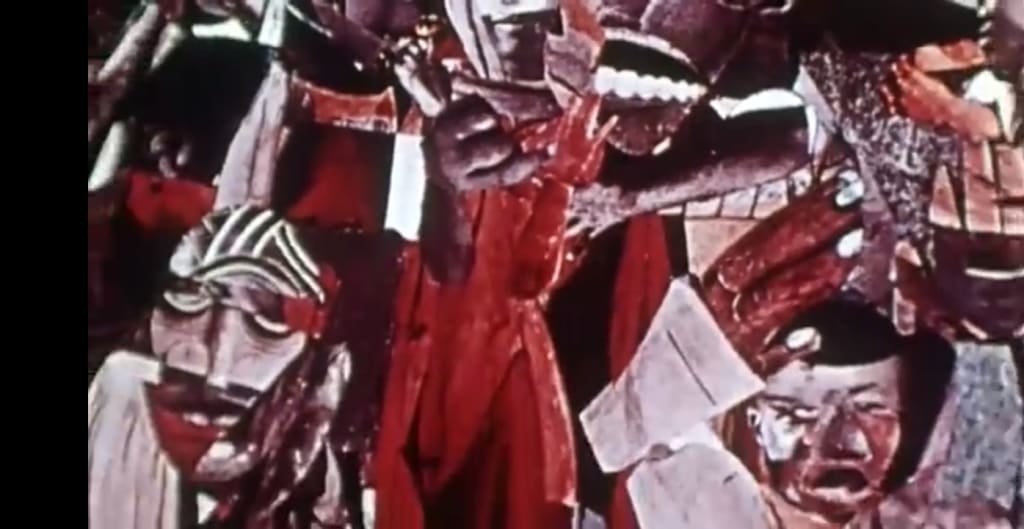
An average art lover takes less than a minute to look into a work of art an artist spent hundreds of days creating!
Research shows that the attention span of an average museum-goer is even less.
We can unlock so much mystery as we delve and lean closely toward the hidden codes in art to discover more.
You don't want to miss an incredible love story, or a hidden Easter egg that unravels, when you take a closer look, you start to notice things that lead to questions like where, when, and why was this amazing thing originally made.
In other words, what's its context? It’s much like how an archaeologist uses tools to uncover artifacts, art historians use tools to uncover the stories behind art. But our tools aren't tiny axes and Spades, they're words like shape, color, line, volume, and texture these help us describe an artwork's form or its purely visual or physical aspects the better we get at noticing and describing what we see in art the more we jiggle the key to unlocking the context behind it.
Let's try it out with Spring Way made in 1964 by the artist Romer Bearden if you were in the same room with this work, the first thing you'd notice is how compact it is about the size of an iPad notice the way it's arranged or its composition by scanning the p from one side to the other and top to bottom or whichever way you want of vibrancy. The strong lines in the artwork, both vertical and horizontal, create a grid-like structure of rectangles and triangles. This grid is interrupted by minimal curves, giving the impression of tall city buildings with textured brick walls. In the image, we can also see a figure climbing the stairs on the right side, adding a representational element to the work.
However, just like not every poem rhymes, not all art aims to depict the world exactly as it is. The figures in this artwork are abstract, meaning they may be recognizable but do not adhere to a realistic representation of people or buildings.
Upon closer inspection, we can observe that "Spring Way" is a collage made up of various papers and clippings on paperboard. This choice of medium demonstrates the artist's deliberate selection of each piece. The color palette used in the artwork is predominantly gray, black, and cream, with occasional bursts of red appearing between layers. These colors evoke a sense of a bleak and harsh environment, with only fleeting moments of vibrancy.
As I reflect on life, I find myself contemplating the context of the artwork and the intentions of the artist. If I delve into the title "Spring Way," I will discover that it is named after an alley in Pittsburgh where the artist resided with his grandparents in the 1920s. This alley was known for housing black individuals who had migrated from the southern states, often working in hazardous conditions at a steel mill. By delving deeper into Bearden's life, I will learn that he was a member of a group of artists called Spiral, who aimed to represent the experiences of black people as a means of contributing to the Civil Rights Movement. All of these details come together to create an artistic experience that extends beyond the visual. One can appreciate its form while also listening to the stories it can convey when exploring its context. Our toolbox as art historians can also help us understand how an artwork originally functioned. For example, consider this object: a Kosi Society elephant mask created by the Bomal people in what is now Cameroon.
In the 1900s, there is a mask with a composition that represents an elephant's features. The mask has large circles on each side to represent the ears and long rectangular panels for the trunk. The use of color enhances the curved shapes of the mask and draws attention to the ears, eyes, and mouth. The intricate design of the mask comes from brightly colored beads sewn onto cloth, along with cowry shells and strips of dried Palm leaves. Based on the materials and technique used, it is assumed that this mask was made for someone wealthy and powerful. The glass beads used in the mask were rare and expensive, symbolizing wealth and status. The mask's significance goes beyond its representation of an elephant. In the context of the Balik culture, powerful animals like elephants are associated with powerful individuals. The style of the mask, with its repeating pattern of triangles arranged in circles, is characteristic of Balik. Additionally, the mask also pays homage to another powerful animal, the leopard.
The text tells us about a mask that was created and worn as part of a masquerade. It was not just for display, but also performance and interaction with the audience. Although we can't see the mask in its original context, it is now housed in the Brooklyn Museum where it can be admired alongside other beadwork and artwork from the same region and time.
By comparing and contrasting different artworks, we can gain a better understanding of their meaning and significance to the people who created and experienced them.
The text also mentions two large stone sculptures, one of which has become widely known through memes. The other, called the Coil Shaki Monolith, was discovered accidentally in Mexico City in 1978. It is carved with the image of a dismembered woman, representing the Moon Goddess Co Shi. This artwork would have been familiar to the Aztecs when it was created in the late 15th century.
Enraged upon discovering that her mother was pregnant with Wheatley Poley, the God of the Sun, the moon goddess made a desperate attempt to kill her mother with the assistance of her 400 brothers. However, the baby Sun God was born fully prepared for battle, possessing an armored adult body. He swiftly decapitated his conniving half-sister and discarded her remains off a mountain. The monolith depicts the aftermath of the moon goddess's defeat. Archaeologists have determined that this stone was initially placed at the bottom of a staircase leading to the grand temple in the Aztec capital of Tanach Titlan. This sculpture symbolized the ultimate destruction of enemies through Aztec strength. Interestingly, war captives were occasionally ritually sacrificed at the top of the temple and rolled down onto this stone, mirroring the myth.
Now, let's compare this to another substantial stone artwork, David, sculpted by the renowned Michelangelo in Florence, Italy. Although created within a few years of the Coixtlahuaca monolith, it is located over 6,000 miles away. Like the monolith, it portrays a legendary battle that was well-known in Europe at the time - the story of David and Goliath. According to the Bible, a giant named Goliath challenged the Israelites to find someone who could defeat him in combat. Only a young shepherd named David, armed with a staff, slingshot, and five rocks, dared to face Goliath. David successfully knocked out Goliath and beheaded him. It is fascinating to note the recurring theme of decapitations in these artworks.
Nevertheless, this particular moment has been a popular subject for many artists throughout history to portray David after overcoming adversity, just like the way the coil Shi monolith depicts the moon goddess after her defeat by Goliath. However, Michelangelo's sculpture of David portrays him as the underdog, determined and with a furrowed brow, holding stones in his hands before the fight. This sculpture was placed in front of Florence's Town Hall during a time when the city was under threat from neighboring armies. The statue became a symbol of the city and its people, representing their resilience. The citizens of Florence saw it as a reminder that they could stand together and overcome challenges.
These two sculptures, created around the same time in different parts of the world, share similarities in their themes of decapitation and nudity. Both were carved from a single piece of stone and displayed in prominent locations in major cities for people to see and understand the stories they represented.
However, there are also significant cultural differences in how they were perceived. Many Italians at the time saw David's nudity as a symbol of triumph and strength, while others may have interpreted it differently.
Heroism was seen differently by different cultures. While the Aztecs viewed Coyle Sha's nakedness as a symbol of humiliation and defeat, others, like the sun gods and giant slayers, saw it as a heroic act. It is important to note that our personal experiences and cultural backgrounds shape how we perceive art, including our feelings towards nudity in artwork.
Art does not exist in isolation; it is connected to the culture, period, and perspective in which it was created.
About the Creator
Enjoyed the story? Support the Creator.
Subscribe for free to receive all their stories in your feed. You could also pledge your support or give them a one-off tip, letting them know you appreciate their work.






Comments
There are no comments for this story
Be the first to respond and start the conversation.